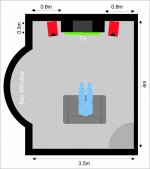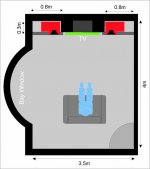I'm intending some active 3-ways, and another thread has suggested the possibility of soffit mounting them. There is a diagram attached of my living room more or less as it is now, with my current small bookshelf speakers (there are other chairs and coffee tables etc not shown). And then another diagram of how I envisage some larger 3-ways could perhaps be built behind a new false wall or soffit. This should turn the awkward alcoves into a smooth flat baffle to work with, and I could also hide quite large bass enclosures with only a small proportion showing and virtually no intrusion into the room.
So.. If I were setting out to design a 3-way specifically for this type of mounting, clearly I wouldn't design my active crossovers for much in the way of baffle step, and presumably I would choose drivers that have a nice flat FR without narrow/shaped baffles to tweak it. And if my false wall is vertical I could perhaps recess the tweeter in a modest waveguide to allign its acoustic centre with the mid (and perhaps control directivity), although I'm also tempted to keep it flush for simplicity. But those are just my ideas and could be naive.
Probably its my ineptitude with the search facility, but I can't find many threads dealing with design criteria for soffit mounting or 'very' wide baffles. There are some room-build threads which are also useful, but often they're for control rooms that require the speakers to be above a large desk and/or window, which I don't need to accomodate. Are there any special things I need to consider in a design for soffit mounting and/or are there any good threads on it?
Many thanks
Kev
So.. If I were setting out to design a 3-way specifically for this type of mounting, clearly I wouldn't design my active crossovers for much in the way of baffle step, and presumably I would choose drivers that have a nice flat FR without narrow/shaped baffles to tweak it. And if my false wall is vertical I could perhaps recess the tweeter in a modest waveguide to allign its acoustic centre with the mid (and perhaps control directivity), although I'm also tempted to keep it flush for simplicity. But those are just my ideas and could be naive.
Probably its my ineptitude with the search facility, but I can't find many threads dealing with design criteria for soffit mounting or 'very' wide baffles. There are some room-build threads which are also useful, but often they're for control rooms that require the speakers to be above a large desk and/or window, which I don't need to accomodate. Are there any special things I need to consider in a design for soffit mounting and/or are there any good threads on it?
Many thanks
Kev
Attachments
Last edited:
With active crossovers smoothness in a driver response is probably more important than flatness. The response is going to be shaped anyway and so including a correction for smooth slopes and bumps is straightforward. This is less so for sharp wiggles particularly if they do not occur off-axis.
You do not want to mount the drivers directly on the baffle. Putting them in their own enclosure and then isolating it is perhaps the simplest and most flexible approach. The reason is that a large flat baffle has the potential to radiate a lot of sound if vibrated.
There is a lot on soffit mounting on the web with much of it being sensible. Pretty much all of the control room information is relevant to your situation despite your reservations about mixing desks and windows (one of which you have). If you do decide to go for soffit mounting then you may well receive better practical advice from forums focussing on the acoustics of small rooms such as this one among several others.
You do not want to mount the drivers directly on the baffle. Putting them in their own enclosure and then isolating it is perhaps the simplest and most flexible approach. The reason is that a large flat baffle has the potential to radiate a lot of sound if vibrated.
There is a lot on soffit mounting on the web with much of it being sensible. Pretty much all of the control room information is relevant to your situation despite your reservations about mixing desks and windows (one of which you have). If you do decide to go for soffit mounting then you may well receive better practical advice from forums focussing on the acoustics of small rooms such as this one among several others.
This site may be of some help.
Table of Contents for Art Ludwig's sound page
There is a wealth of information here on almost everything (so a lot of time or some good filtering is required), but go directly here - http://www.silcom.com/~aludwig/images/roomint.jpg - to see the system he ended up building.
Table of Contents for Art Ludwig's sound page
There is a wealth of information here on almost everything (so a lot of time or some good filtering is required), but go directly here - http://www.silcom.com/~aludwig/images/roomint.jpg - to see the system he ended up building.
Thanks chaps - those links look most useful!
Thanks also for the advice Andy; yes I could probably rise to some sort of correction for smooth slopes so that would widen my choice of drivers. I did a bit of research on the IEC test baffle size last night and its a bit larger than I thought, so maybe manufacturer's FR charts could be useful guides to choosing drivers in this case.
Cheers
Kev
Thanks also for the advice Andy; yes I could probably rise to some sort of correction for smooth slopes so that would widen my choice of drivers. I did a bit of research on the IEC test baffle size last night and its a bit larger than I thought, so maybe manufacturer's FR charts could be useful guides to choosing drivers in this case.
Cheers
Kev
I think the window can be dealt with simply by using heavy curtains across the bay.
An approach I've come across in studios where the curtains are open during tracking to maintain visual contact with the musicians and closed during mixing to avoid nasty reflections.
You might find some useful info here:Acoustic Curtains
Of course I would not buy from them since running up some curtains would be the easiest part of your project, just find the right material and get cracking!
It may even be possible to involve your better half.
Given the size of the IEC baffle the manufacturers charts are probably more reliable for your situation than for 'normal' speakers, at least for mids and treble.
As for the bass driver I think your choices may have increased since it should be easy to disguise quite a large volume bass enclosure. You've got about 500L to play with at a rough estimation.
I also think that a waveguide for the tweeter is a good idea for lowering distortion as much as for dispersion control. See the measurements in this thread which are quite impressive:
http://www.diyaudio.com/forums/multi-way/241286-my-first-wave-guide-speaker-lots-pics.html
PS: I'd recommend a nice rug as a wall hanging opposite the bay window to keep any remaining reflections symmetrical if it fits into your interior decoration scheme.
An approach I've come across in studios where the curtains are open during tracking to maintain visual contact with the musicians and closed during mixing to avoid nasty reflections.
You might find some useful info here:Acoustic Curtains
Of course I would not buy from them since running up some curtains would be the easiest part of your project, just find the right material and get cracking!
It may even be possible to involve your better half.
Given the size of the IEC baffle the manufacturers charts are probably more reliable for your situation than for 'normal' speakers, at least for mids and treble.
As for the bass driver I think your choices may have increased since it should be easy to disguise quite a large volume bass enclosure. You've got about 500L to play with at a rough estimation.
I also think that a waveguide for the tweeter is a good idea for lowering distortion as much as for dispersion control. See the measurements in this thread which are quite impressive:
http://www.diyaudio.com/forums/multi-way/241286-my-first-wave-guide-speaker-lots-pics.html
PS: I'd recommend a nice rug as a wall hanging opposite the bay window to keep any remaining reflections symmetrical if it fits into your interior decoration scheme.
Last edited:
Thanks for those suggestions! Thick curtains and some sort of hanging should be very do-able, and I'm glad the manufacturers charts could be reasonably reliable (for mid and tweeter); I'll probably have more confidence to select drivers of my own choice, rather than copying other designs.
Thye waveguide is an interesting one; I was mainly considering the possibility in order to time-align the tweeter and mid, but the more I read about waveguides the more interested i become. The main challenge seems to be finding them; there seems to be a very restricted selection of tweeters with taylored waveguides available, but even if I went for a more generic waveguide I'm struggling to find any that I don't need to import - I guess that isn't a show-stopper where suppliers will post internationally though. I know that people have made their own and I'm sure I have the ability to make one, but I'm doubtful of my ability to design them very well acoustically speaking..
Cheers
kev
Thye waveguide is an interesting one; I was mainly considering the possibility in order to time-align the tweeter and mid, but the more I read about waveguides the more interested i become. The main challenge seems to be finding them; there seems to be a very restricted selection of tweeters with taylored waveguides available, but even if I went for a more generic waveguide I'm struggling to find any that I don't need to import - I guess that isn't a show-stopper where suppliers will post internationally though. I know that people have made their own and I'm sure I have the ability to make one, but I'm doubtful of my ability to design them very well acoustically speaking..
Cheers
kev
- Status
- Not open for further replies.

